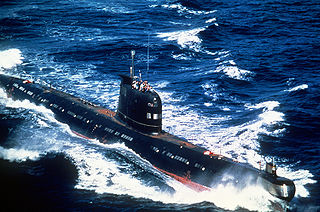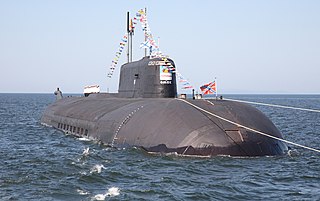Design
Project 971 has a double-hull design. The robust body is made of high quality alloy steel with σт = 1 GPa (10,000 kgf / cm²). To simplify the installation of equipment, the boat was designed using zonal blocks, which made it possible to transfer a significant amount of work from the cramped conditions of the sub's compartments directly to the workshop. After completion of the installation, the zonal unit is “rolled” into the hull of the boat and connected to the main cables and pipelines of the ship's systems. [6] A two-stage damping system is used: all mechanisms are placed on damped foundations, in addition, each zone unit is isolated from the body by rubber-cord pneumatic shock absorbers. [6] In addition to reducing the overall noise level of nuclear submarines, such a scheme can reduce the impact of underwater explosions on equipment and crew. [7] [6] The boat has a developed vertical tail unit with a streamlined boule, in which the towed antenna is located. Also on the submarine are two reclining thrusters and retractable bow horizontal rudders with flaps. A feature of the project is the smoothly mated connection of the tail unit to the hull. This is done to reduce noise-generating hydrodynamic eddies.
Power supply is carried out by a nuclear power plant. The lead boat, K-284 Akula, is equipped with an OK-650M.01 pressurized water-cooled nuclear reactor. On later orders, the AEU has minor improvements. Some sources report that subsequent boats are equipped with OK-9VM reactors. [8] The thermal power of the reactor is 190 MW, the shaft power is 50,000 liters. with. Two auxiliary electric motors in the hinged outboard columns have a capacity of 410 hp. with., there is one diesel generator ASDG-1000.
Construction and career
The submarine was laid down on 6 November 1986 at Sevmash, Severodvinsk. Launched on 21 May 1990 and commissioned on 27 December 1990. [9]
Initially, the boat carried only tactical numbers, but on 10 October 1990, the Commander-in-Chief of the USSR Navy V.N. which opened in 1919, gave the name Pantera. [10]
In 1993, under the leadership of Captain I Rank Vasily Mikhalchuk, the crew of the boat won the prize of the Commander-in-Chief of the Navy and took first place in the Navy in anti-submarine training. [11]
In 1996, during a military campaign, as a result of an accident in the refrigeration system, freon began to flow into the compartments, the crew was able to eliminate the malfunction on their own without surfacing. [12]
In January 1999, the commander of the submarine, Captain 1st Rank Sergei Spravtsev was awarded the title of Hero of Russia. [12]
Until the end of the 1990s, he made 2 military campaigns and performed a search operation. [10]
The submarine needed to replace the battery, the GAK needed to be repaired. [10]
On 2 November 2006, during the welding work in the third compartment, a fire broke out. Two firefighters were poisoned by combustion products. [12] [13]
His overhaul and modernization were completed in 2007. [14] During the repair, the hydroacoustic complex, communication and control equipment were modernized. [15]
On 28 January 2008, after the completion of the repair, he was accepted into the combat composition of the Navy. he became a part of the 24th submarine of the 12th Eskpl of the Northern Fleet (Gadzhiyevo) based in the Yagelnaya Bay of the Sayda Bay. [13]
Pennant numbers
| Date | Pennant number [9] |
|---|
| 1991 | 039 |
| 2000 | 878 |

The Oscar class, Soviet designations Project 949 Granit and Project 949A Antey, are a series of nuclear-powered cruise missile submarines designed in the Soviet Union for the Soviet Navy. First built in the 1970s, six remain in service with the Russian Navy. Two other vessels were slated to be modernized since at least 2017 as Project 949AM, to extend their service life and increase combat capabilities but it is unclear whether work continues as of 2023.

The Akula class, Soviet designation Project 971 Shchuka-B is a series of fourth generation nuclear-powered attack submarines (SSNs) first deployed by the Soviet Navy in 1986. There are four sub-classes or flights of Shchuka-B, consisting of the original seven Project 971 boats, commissioned between 1984 and 1990; six Project 971Is, commissioned between 1991 and 2009; one Project 971U, commissioned in 1995; and one Project 971M, commissioned in 2001. The Russians call all of the submarines Shchuka-B, regardless of modifications.

The Foxtrot class was the NATO reporting name of a class of diesel-electric patrol submarines that were built in the Soviet Union. The Soviet designation of this class was Project 641. The Foxtrot class was designed to replace the earlier Zulu class, which suffered from structural weaknesses and harmonic vibration problems that limited its operational depth and submerged speed. The first Foxtrot keel was laid down in 1957 and commissioned in 1958 and the last was completed in 1983. A total of 58 were built for the Soviet Navy at the Sudomekh division of the Admiralty Shipyard, Saint Petersburg. Additional hulls were built for other countries.

ТК-202 was a ballistic missile submarine of the Russian Navy, formerly having served in the Soviet Navy.

The Sierra class, Soviet designations Project 945 Barrakuda and Project 945A Kondor,, are a series of nuclear-powered attack submarines intended for the Soviet Navy and currently in service with the Russian Navy.
The K-119 Voronezh is an Oscar-class submarine in the Russian Navy.

The K-186 Omsk is an Oscar-class submarine in the Russian Navy.

The K-410 Smolensk is an Oscar-class submarine in the Russian Navy.
The K-132 Irkutsk is an Oscar-class submarine in the Russian Navy.

The K-419 Kuzbass is an Akula-class submarine in the Russian Navy.

The K-328 Leopard is an Akula-class submarine in the Russian Navy.
The K-154 Tigr is an Akula-class submarine in the Russian Navy.

The K-263 Barnaul was an Akula-class submarine of the Russian Navy.

The K-322 Kashalot was an Akula-class submarine in the Russian Navy.

The K-331 Magadan is an Akula-class submarine in the Russian Navy.
The K-391 Bratsk is an Akula-class submarine in the Russian Navy.
The K-461 Volk (En:Wolf) is an Akula-class submarine of the Russian Navy.
The K-480 Ak Bars is an Akula-class submarine in the Russian Navy.
The K-295 Samara is an Akula-class submarine in the Russian Navy.

The K-335 Gepard is an Akula-class submarine in the Russian Navy.
This page is based on this
Wikipedia article Text is available under the
CC BY-SA 4.0 license; additional terms may apply.
Images, videos and audio are available under their respective licenses.













